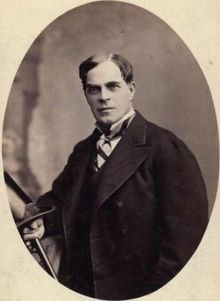Barry Sullivan (English actor)

Barry Sullivan (christened Thomas Barry Sullivan; 5 July 1821 – 3 May 1891), was an acclaimed stage actor who played many classical parts in England, Australia and America.[1]
Early life
Thomas Barry Sullivan was born at Howard's Place,[2] Birmingham, Warwickshire, England, son of Peter and Mary (née Barry) Sullivan, both natives of Cork, Ireland. Thomas Barry was orphaned at eight years old.[1]
Sullivan was then raised by his paternal grandfather in
Early acting career

In 1837, Sullivan joined a strolling company and at Cork was given an engagement at 15
Sullivan soon began to play leading roles, in 1844 he took the part of
Sullivan was now established as a leading actor and played principal parts during the next eight years in most of the plays of the period including Claude Melnotte in The Lady of Lyons with Helena Faucit as Pauline, and Valence in Browning's Colombe's Birthday, with Helena Faucit in the part of Colombe.[2]
Towards the end of 1858 Sullivan went to the United States of America, and opened at the
Career in Australia


On 25 July 1862 Sullivan arrived in
The period between 1860 and 1870 was one of the highest standards of acting seen in Australia.[2] Brooke was usually at his best in Australia, Joseph Jefferson was at his best and had not yet begun to restrict the range of his characters, and Sullivan had the advantage, sometimes lacking later in England, of always having excellent support from his companies.[2] Sullivan's parts in Australia included Hamlet, Othello, Iago, Richard III, Macbeth, Shylock, Lear, Falstaff, Falconbridge, Charles Surface, Claude Melnotte, and Richelieu. Sullivan became established as a public favourite.[2]
Sullivan was sole lessee and manager of the Theatre Royal, Melbourne from March 1863 to 16 February 1866, when he played his last night and relinquished management. His last year's lease he sublet to William Hoskins.[5]
Sullivan completed a trip around the world in 1866, arriving in London early in September. From 1868 to 1870 he managed the Holborn theatre,[1] where Beverley in The Gamester was one of his most powerful impersonations.[6]
In the next 20 years Sullivan was constantly playing in London, the provinces and in the United States,
Sullivan's health had been uncertain for some time and in the following year he suffered a stroke of paralysis. He was so ill in August 1888 that the last rites of his church were administered, but did not die until 3 May 1891. His wife and two sons and three daughters survived him.[1]
Sullivan was five feet nine inches (175 cm) tall[2] and had a wiry, slight figure which allowed him to play younger parts when he was middle-aged.[1] For a long period Sullivan was one of the finest actors of his period, though at times inclined to err on the robust side.[2] In Melbourne Sullivan's death resulted in lengthy obituaries; he was remembered as an actor and manager of 'more than ordinary talent, combined with considerable force of character, great tenacity of purpose, untiring industry, and a dogged application to the business of his profession'.[7]
Notes
- ^ MUP, 1976, p. 219. Retrieved 6 April 2010
- ^ a b c d e f g h i j k l m n o p q Serle, Percival (1949). "Sullivan, Barry". Dictionary of Australian Biography. Sydney: Angus & Robertson. Retrieved 6 April 2010.
- ISBN 0-9531820-0-2.
- ISBN 1-55783-561-6.]
- ^ "Advertising". The Age. No. 3, 522. Victoria, Australia. 12 February 1866. p. 8. Retrieved 9 October 2021 – via National Library of Australia.
- ^ Chisholm 1911.
- ^ The Argus 5 May 1891.
Sources
- This article incorporates text from a publication now in the public domain: Chisholm, Hugh, ed. (1911). "Sullivan, Thomas Barry". Encyclopædia Britannica. Vol. 26 (11th ed.). Cambridge University Press. p. 57.
- Knight, John Joseph (1898). . In Lee, Sidney (ed.). Dictionary of National Biography. Vol. 55. London: Smith, Elder & Co.
- O'Connor, Barry (2004). "Sullivan, (Thomas) Barry (1821–1891)". doi:10.1093/ref:odnb/26773. (Subscription or UK public library membershiprequired.)
External links
 Media related to Barry Sullivan (stage actor) at Wikimedia Commons
Media related to Barry Sullivan (stage actor) at Wikimedia Commons
